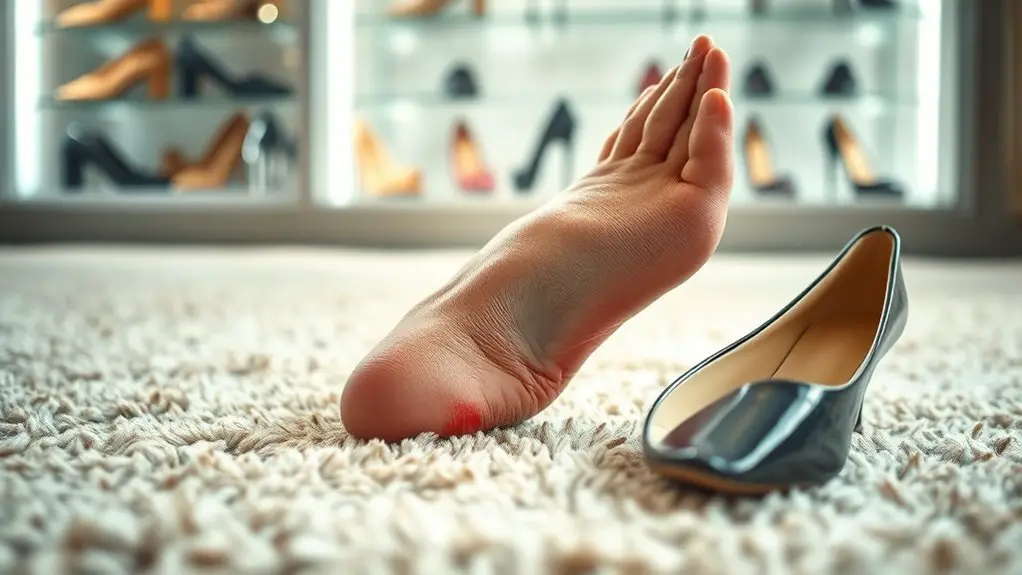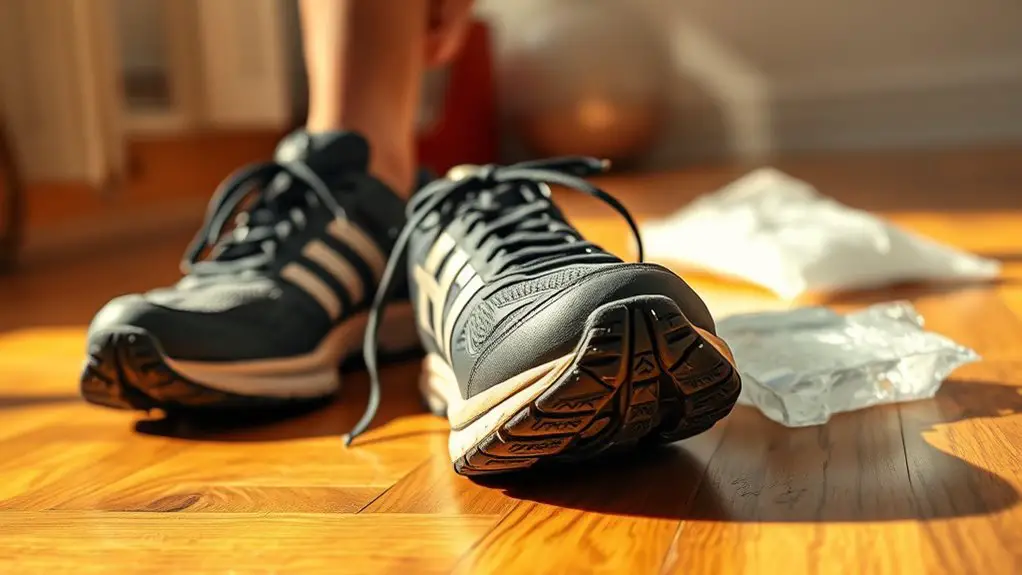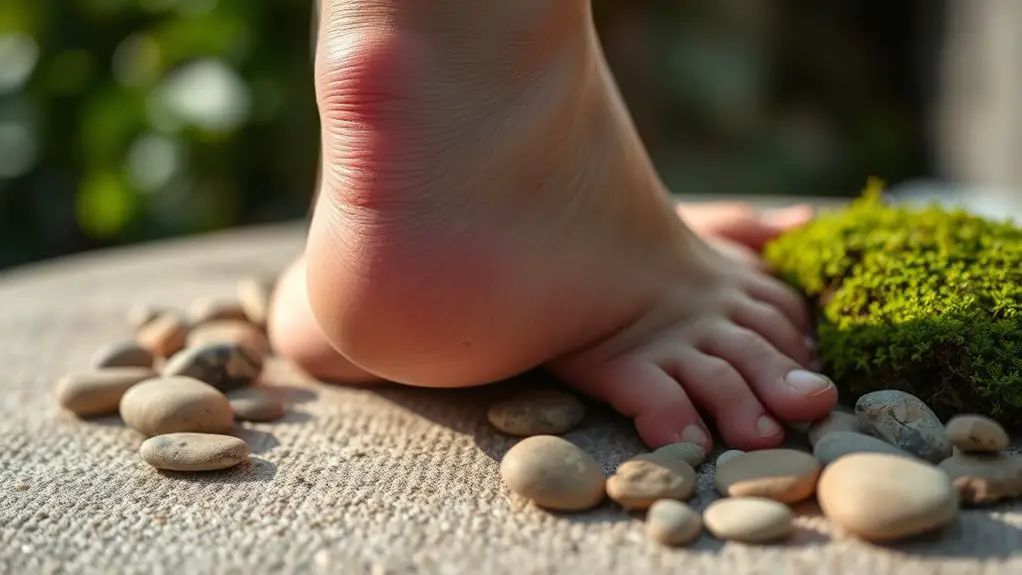Heel pain can arise from various conditions, including plantar fasciitis, Achilles tendinitis, heel spurs, bursitis, and stress fractures. Ill-fitting shoes and arthritis can also contribute to discomfort. Each condition requires a targeted approach for relief, which may involve stretching exercises, custom orthotics, and proper footwear. A balanced training routine with adequate rest is essential in preventing issues. For more detailed insights on causes, treatments, and preventive measures, you can explore further.
Understanding Heel Pain: An Overview

Heel pain is a common issue that can arise from various underlying conditions, often impacting your daily activities. Understanding heel anatomy is vital for effective pain management. The heel consists of several structures, including the calcaneus bone, tendons, ligaments, and fascia. When any of these components become strained or damaged, you may experience pain.
Common factors contributing to heel pain include overuse, improper footwear, and anatomical abnormalities. Conditions like bursitis, Achilles tendinitis, or heel spurs can manifest as discomfort in the heel area.
To manage heel pain effectively, it’s important to assess your activity levels and footwear choices. Stretching and strengthening exercises can aid in recovery, while ice application and anti-inflammatory medications may alleviate symptoms. Consulting a healthcare professional is essential for an accurate diagnosis and personalized treatment plan, ensuring you can return to your regular activities with minimal discomfort.
Plantar Fasciitis: The Most Common Culprit
While many factors can contribute to heel pain, plantar fasciitis stands out as the most prevalent condition affecting individuals. This condition occurs when the plantar fascia, a thick band of tissue connecting your heel to the front of your foot, becomes inflamed. You might experience sharp pain in the heel or along the arch, especially in the morning or after prolonged periods of sitting.
Common plantar fasciitis symptoms include stiffness, swelling, and a persistent ache that worsens with activity. Recognizing these signs early can lead to more effective management.
For plantar fasciitis treatments, conservative options often include stretching exercises, physical therapy, or the use of orthotic devices. Nonsteroidal anti-inflammatory medications may help reduce pain and inflammation. In more severe cases, your healthcare provider might recommend corticosteroid injections or, in rare instances, surgery. Prompt and appropriate treatment is essential to alleviate symptoms and restore normal function.
Achilles Tendinitis: Inflammation and Discomfort

Achilles tendinitis often presents as pain and stiffness along the back of your heel, particularly after periods of inactivity. Understanding the risk factors and causes is essential for effective management. Exploring treatment and recovery options can help alleviate discomfort and restore function.
Symptoms of Achilles Tendinitis
Tendon inflammation can lead to a range of symptoms that may signal Achilles tendinitis. You might experience achilles pain, often felt at the back of your heel or along the tendon itself. This discomfort can worsen with activity, particularly during walking, running, or climbing stairs. Swelling may also occur, accompanied by stiffness, especially in the morning or after prolonged periods of inactivity. You may notice a creaking or crackling sound when moving your foot. Additionally, tenderness to the touch is common, and the affected area may feel warm. If these symptoms persist or intensify, it’s essential to seek medical attention to prevent further complications and address the underlying tendon inflammation effectively.
Risk Factors and Causes
Understanding the risk factors and causes of Achilles tendinitis is essential for prevention and effective management. Several risk factors contribute to this condition, including age, overuse, and improper footwear. As you age, your tendon becomes less flexible, increasing the likelihood of inflammation. Engaging in high-impact activities without proper conditioning can also lead to tendinitis. Additionally, wearing shoes that lack adequate support or cushioning can exacerbate discomfort. Other contributing factors include flat feet or high arches, which can alter your walking mechanics. If you have a history of tendon injuries, you’re at a higher risk as well. Recognizing these factors can help you make informed decisions to protect your Achilles tendon from strain and injury.
Treatment and Recovery Options
When dealing with the inflammation and discomfort caused by tendinitis, timely treatment and recovery options become paramount. First, consider implementing self-care strategies like rest, ice application, and over-the-counter anti-inflammatory medications to reduce pain and swelling. Gradually, you can incorporate rehabilitation techniques, such as stretching and strengthening exercises, tailored to your condition. Physical therapy may also be beneficial, helping to restore flexibility and strength in the Achilles tendon. Avoid high-impact activities during recovery, opting instead for low-impact exercises like swimming or cycling. Regularly assess your progress, and consult a healthcare professional if discomfort persists. Following these steps will facilitate healing and enable you to return to your normal activities without further complications.
Heel Spurs: When Bone Meets Soft Tissue

Heel spurs are bony projections that develop on the bottom of your heel bone, often as a result of repetitive stress and inflammation. They can cause significant discomfort when they press against soft tissues in the foot. Understanding treatment options is essential for managing pain and restoring mobility.
What Are Heel Spurs?
A heel spur is a bony growth that occurs on the underside of the heel bone, often resulting from chronic stress and inflammation where the bone meets the surrounding soft tissue. Understanding heel anatomy can help you grasp how spur formation takes place, typically due to repetitive strain from activities like running or standing for long periods.
| Factor | Description | Impact on Heel Spurs |
|---|---|---|
| Chronic Stress | Continuous pressure on the heel | Encourages spur formation |
| Inflammation | Swelling of soft tissues | Increases pain and discomfort |
| Activity Level | High-impact sports or prolonged standing | Heightens risk of heel spurs |
| Foot Structure | Flat feet or high arches | Affects weight distribution |
| Age | Older adults may be more prone | Decreases bone density |
Treatment Options Available
Understanding the implications of heel spurs on daily activities is vital for seeking effective treatment options. To alleviate pain, custom orthotics can provide vital support by redistributing pressure on your feet. These devices help correct abnormal foot mechanics, which can reduce strain on the heel. Additionally, incorporating stretching exercises into your routine can greatly improve flexibility and reduce tension in the Achilles tendon and plantar fascia. Targeted exercises, such as calf stretches and toe raises, can be particularly beneficial. It’s important to remain consistent with these practices to enhance recovery and prevent future discomfort. If pain persists, consulting a healthcare professional for further evaluation and potential interventions, like physical therapy or corticosteroid injections, may be necessary.
Bursitis: Inflammation of the Fluid-Filled Sacs
When inflammation occurs in the bursa—small, fluid-filled sacs that cushion bones, tendons, and muscles near your joints—it can lead to a condition known as bursitis. This inflammation often results in heel pain and discomfort.
You may experience several bursitis symptoms, including:
- Localized pain in the heel
- Swelling and tenderness
- Stiffness in the affected area
- Limited range of motion
- Pain that worsens with activity
For effective bursitis treatment, consider the following approaches:
- Resting the affected area
- Applying ice to reduce swelling
- Taking over-the-counter anti-inflammatory medications
- Wearing cushioned footwear for support
- Consulting a healthcare provider for further evaluation
Recognizing these signs and seeking appropriate treatment can help manage your symptoms and restore normal function. If pain persists, professional guidance is essential for a thorough assessment and tailored treatment plan.
Stress Fractures: Microfractures From Overuse
Stress fractures, which are tiny cracks in the bone caused by repetitive force or overuse, can often lead to significant discomfort in the heel. These microfractures typically occur in individuals who engage in high-impact activities, such as running or jumping, without adequate recovery time. You might experience localized pain, swelling, or tenderness that worsens with activity and improves with rest.
To prevent stress fractures, effective stress management is vital. This includes balancing your training intensity with sufficient rest periods, allowing your bones to recover and maintain ideal bone health. Additionally, incorporating strength training and flexibility exercises can help fortify the muscles surrounding your heel, reducing the risk of injury. If you suspect you have a stress fracture, consult a healthcare professional for accurate diagnosis and treatment, which may include rest, ice, and a gradual return to activity. Prioritizing your bone health is essential for long-term mobility and comfort.
Ill-Fitting Shoes: A Common but Overlooked Cause
Foot pain can also stem from ill-fitting shoes, a common but overlooked cause. Wearing the wrong shoe size or lacking adequate arch support can lead to discomfort and exacerbate heel pain. Many people prioritize style over fit, which can result in lasting damage. To guarantee your footwear supports your feet properly, consider the following factors:
- Correct shoe size: Measure your feet regularly, as sizes can change over time.
- Arch support: Choose shoes that provide the necessary support for your foot type.
- Toe box space: Make sure there’s enough room for your toes to move comfortably.
- Heel height: Opt for a moderate heel height to minimize strain on your heels.
- Material: Select breathable materials to reduce moisture and prevent friction.
Addressing these issues can greatly alleviate heel pain and improve your overall foot health.
Arthritis: Joint Pain and Its Impact on Heels
Although arthritis is often associated with joint pain in the hands and knees, it can also greatly affect the heels. Both osteoarthritis and rheumatoid arthritis can lead to inflammation and pain in the heel area, impacting your mobility and daily activities. The degeneration of cartilage in osteoarthritis may cause bone-on-bone friction, resulting in discomfort during movement. In rheumatoid arthritis, the immune system attacks the joints, leading to swelling and stiffness that can extend to the heel.
You might notice that heel pain worsens after periods of inactivity or prolonged standing. Effective osteoarthritis management can include physical therapy, weight management, and lifestyle modifications aimed at reducing stress on the heels. If you have rheumatoid arthritis, disease-modifying antirheumatic drugs (DMARDs) can help control inflammation. Recognizing the impact of arthritis on your heels is essential for finding relief and improving your quality of life.
Effective Treatments and Preventive Measures
Managing heel pain effectively involves a combination of treatments and preventive measures tailored to the underlying causes, such as arthritis. To alleviate discomfort and prevent further issues, consider the following strategies:
- Custom orthotics: These can provide support and improve foot alignment.
- Stretching exercises: Regularly stretching your calf and Achilles tendons can enhance flexibility and reduce strain on your heels.
- Footwear adjustments: Opt for shoes with adequate arch support and cushioning to minimize impact.
- Weight management: Maintaining a healthy weight reduces pressure on your feet.
- Cold therapy: Applying ice to the affected area can help reduce inflammation and relieve pain.
Frequently Asked Questions
Can Heel Pain Be a Sign of a Serious Condition?
Yes, heel pain can indicate serious conditions. Certain heel conditions may arise from serious injuries or underlying issues. It’s essential to consult a healthcare professional if you experience persistent or severe pain for proper evaluation and treatment.
How Can I Prevent Heel Pain During Exercise?
Imagine you’re running in worn-out shoes. To prevent heel pain, invest in proper footwear and consider exercise modification, like reducing intensity or switching to low-impact activities. These steps can greatly reduce strain on your heels.
Are There Specific Stretches to Relieve Heel Pain?
Yes, specific stretching techniques can relieve heel pain. Effective exercises like calf stretches, plantar fascia stretches, and Achilles tendon stretches help improve flexibility and reduce tension, providing relief and enhancing overall foot health.
When Should I See a Doctor for Heel Pain?
If your heel pain persists beyond a few weeks, worsens, or is accompanied by swelling, numbness, or difficulty walking, it’s time for a medical evaluation. Early intervention can prevent further complications and promote recovery.
Do Certain Foot Shapes Affect Heel Pain Likelihood?
Yes, certain foot shapes can influence heel pain likelihood. Foot anatomy affects biomechanics, and improper shoe impact can exacerbate discomfort. Wearing supportive footwear tailored to your foot shape may help mitigate heel pain risk.



